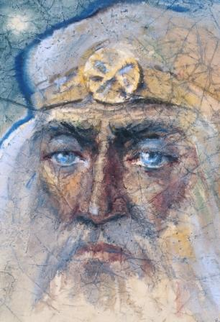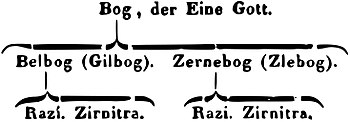Slavic Native Faith's theology and cosmology
Native gods (rodniye bogi) are the essences of the faces of the single Rod, his creative powers, comprehended by us in our personal spiritual experience.
Slavic Native Faith (Rodnovery) has a theology that is generally monistic, consisting in the vision of a transcendental, supreme God (Rod, "Generator") which begets the universe and lives immanentised as the universe itself (pantheism and panentheism), present in decentralised and autonomous way in all its phenomena, generated by a multiplicity of deities which are independent hypostases, facets, particles or energies of the consciousness and will of the supreme God itself.
[3] Polytheism, that is the worship of the gods or spirits, and ancestors, the facets of the supreme Rod generating all phenomena, is an integral part of Rodnovers' beliefs and practices.
The universe is described as a "dialectically unfolding manifestation" of the single transcendental beginning, end each subsequent emanation, every deity and entity, is endowed with ontological freedom, spontaneous will to life and co-creation with the supreme law of God (Prav, "Right") in the great oneness of which they are part.
[8] Both in Russia and in Ukraine, modern Rodnovers are divided among those who are monotheists and those who are polytheists;[9] in other words, some emphasise a unitary principle of divinity, while others put emphasis on the distinct gods and goddesses.
[18] Rod is also "Time" (Kolo), scanned by the cycle of the Sun, ad reflected in the turning of the hours, the days, the months, the seasons, and the year.
[20] Mathieu-Colas defines Rod as the "primordial God", but the term also literally means the generative power of the family and "kin", "birth", "origin" and "fate" as well.
[40] Sylenko acknowledged that the ancient Slavs were polytheists but believed that a monotheistic view reflected an evolution in human spiritual development and thus should be adopted.
[44] According to the Book of Veles, and to the doctrine accepted by many Rodnover organisations, the supreme Rod begets Prav (literally "Right" or "Order"; cf.
Greek Orthotes, Sanskrit Ṛta) in primordial undeterminacy (chaos), giving rise to the circular pattern of Svarog ("Heaven", "Sky"; cf.
[52] According to Shnirelman, this triune vision and associations were codified by Yury P. Mirolyubov and further elaborated by Valery Yemelyanov, both interpreters of the Book of Veles.
[53] Adam of Bremen described the Triglav of Wolin as Neptunus triplicis naturae (that is to say "Neptune of the three natures/generations") attesting the colours that were associated to the three worlds, then further studied by Karel Jaromír Erben: white for Heaven, green for Earth and black for the underworld.
[14] According to the studies of Jiří Dynda, the three faces of Triglav are rather Perun in the heavenly plane (instead of Svarog), Svetovid in the centre from which the horizontal four directions unfold, and Veles in the underworld.
He gives weight to the Triglav as a representation of what Georges Dumézil studied as the "Indo-European trifunctional hypothesis" (holy, martial and economic functions reflected by three human types and social classes).
[58] By Ebbo's words, the Triglav is summus deus, the god representing the "sum" of the three dimensions of reality as a mountain or tree (themselves symbols of the axis mundi).
[60] His four faces are the masculine Svarog ("Heaven", associated to the north direction and the colour white) and Perun ("Thunder", the west and red), and the feminine Mokosh ("Wetness", the east and green) and Lada ("Beauty", the south and black).
[64] Ultimately, Svetovid embodies in unity the supreme duality (Belobog and Chernobog) through which Rod manifests itself as Prav, and the axial interconnection of the three times with the four dimensions of present space.
In other words, he represents Prav spiritualising Yav as Nav; or Svarog manifesting as spirit (Perun) in the material world governed by Veles.
Dynda says that this conception reflects a common Indo-European spiritual vision of the cosmos, the same which was also elaborated in early and medieval Christianity as God who is at the same time creator (father), creature (son) and creating activity (spirit).
[19] In her theological commentaries to the Book of Veles, the Ukrainian Rodnover leader Halyna Lozko emphasises the cosmological unity of the three planes of Heaven, Earth and humanity between them.
The Russian volkhv Dobroslav emphasises the importance of blood heritage, since, according to him, the violation of kinship purity brings about the loss of the relationship with the kin's divine ancestor.
[72] The Ukrainian Rodnover and scholar Yury Shylov has developed a theory of God as a spiral "information field" that expresses itself in self-conscious humanity, which comes to full manifestation in the Indo-European "Saviour" archetype.





